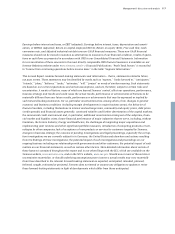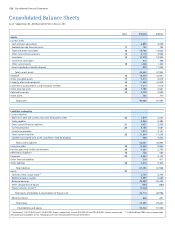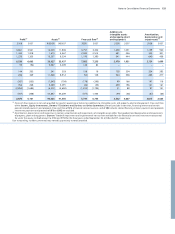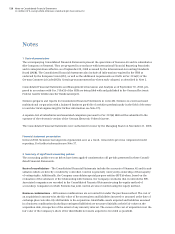Siemens 2008 Annual Report Download - page 223
Download and view the complete annual report
Please find page 223 of the 2008 Siemens annual report below. You can navigate through the pages in the report by either clicking on the pages listed below, or by using the keyword search tool below to find specific information within the annual report.
Notes to Consolidated Financial Statements 127
(in millions of €, except where otherwise stated and per share amounts)
Associated companies – Companies in which Siemens has the ability to exercise signicant inuence over oper-
ating and nancial policies (generally through direct or indirect ownership of 20% to 50% of the voting rights)
are recorded in the Consolidated Financial Statements using the equity method of accounting and are initially
recognized at cost. The excess of Siemens’ initial investment in associated companies over Siemens’ ownership
percentage in the underlying net assets of those companies is attributed to certain fair value adjustments with
the remaining portion recognized as goodwill. Goodwill relating to the acquisition of associated companies is
included in the carrying amount of the investment and is not amortized but is tested for impairment as part of
the overall investment in the associated company. Siemens’ share of its associated companies’ post-acquisition
prots or losses is recognized in the income statement, and its share of post-acquisition movements in equity
that have not been recognized in the associates’ prot or loss is recognized directly in equity. The cumulative
post-acquisition movements are adjusted against the carrying amount of the investment in the associated com-
pany. When Siemens’ share of losses in an associated company equals or exceeds its interest in the associate,
Siemens does not recognize further losses, unless it incurs obligations or makes payments on behalf of the asso-
ciate. Material intercompany results arising from transactions between Siemens and its associated companies
are eliminated to the extent of Siemens’ interest in the associated company.
Foreign currency translation – The assets and liabilities of foreign subsidiaries, where the functional currency
is other than the euro, are translated using period-end exchange rates, while the statements of income are trans-
lated using average exchange rates during the period. Differences arising from such translations are recognized
within equity.
The exchange rates of the signicant currencies of non-euro countries used in the preparation of the Consoli-
dated Financial Statements were as follows:
Revenue recognition – Revenue is recognized for product sales when persuasive evidence of an arrangement
exists, delivery has occurred or services have been rendered, the risks and rewards of ownership have been
transferred to the customer, the amount of revenue can be measured reliably, and collection of the related
receivable is reasonably assured. If product sales are subject to customer acceptance, revenue is not recognized
until customer acceptance occurs. Revenues from construction-type projects are generally recognized under
the percentage-of-completion method, based on the percentage of costs to date compared to the total estimated
contract costs, contractual milestones or performance. Revenues from service transactions are recognized as
services are performed. For long-term service contracts, revenues are recognized on a straight-line basis over
the term of the contract or, if the performance pattern is other than straight-line, as the services are provided.
Revenue from software arrangements is recognized at the time persuasive evidence of an arrangement exists,
delivery has occurred, the amount of revenue can be measured reliably and collectibility is probable. Revenue
from maintenance, unspecied upgrades or enhancements and technical support is allocated using the residual
value method and is recognized over the period such items are delivered. If an arrangement to deliver software
requires signicant production, modication, or customization of software, the entire arrangement is accounted
for under the percentage-of-completion method. Operating lease income for equipment rentals is recognized on
Year-end exchange
rate 1 € quoted into
currencies specied
below
Annual average
rate 1 € quoted into
currencies specied
below
September 30, Fiscal year
Currency ISO Code 2008 2007 2008 2007
U.S. Dollar USD 1.430 1.418 1.507 1.333
British pound GBP 0.790 0.697 0.763 0.676
























